Discussed in this post: 3 Books (A Special Hell; Taking Sides; This is Not a Program); 6 Movies (The Lobster; Alps; Attenberg; Miss Violence; Hunt For the Wilderpeople; Personal Shopper); and 2 Documentaries (Incident at Restigouche; They Call Us Monsters).
Books
1. A Special Hell: Institutional Life in Alberta’s Eugenic Years by Claudia Malacrida.

It is not frequently noted, in the histories of Canada that we learn as children in school, that up until the early 1970s it was common for Canadian medical, institutional, and governmental parties to co-operate in order to sterilize men, women, children, and teenagers who had developmental disabilities (or who were said to have developmental disabilities because the scored low on IQ tests that were not administered in their first language or contained content irrelevant to their cultural background or because the person taking the test was barely literate or being prescribed and forced to take a large amount of tranquilizers). I had already come across some of the history of the sterilization of Indigenous peoples in the territories occupied by Canada (cf. Karen Stote’s essential text, An Act of Genocide: Colonization and the Sterilization of Aboriginal Women) but I knew very little about the institutionalization and sterilization of people with developmental disabilities. I mean, sure, I knew the general horror stories about the institutions – the Titicut Follies and Willowbrook: The Last Great Disgrace provide some very hard to see insights into those things – and I also knew the devastating outcomes that were produced by governments that shut down those institutions without making any real plans for the former residents (many people ended up homeless or very quickly hooked onto street drugs or both, and many died as a result of that – it’s a classic government move, finally be forced to recognize abuses that have to be addressed and then take the most cost effective approach and fuck everyone with the supposed solution, all while branding yourself as a hero and savior and moral actor) – but I knew little about sterilizations or the racist, Christian discourse of eugenics that motivated so much of this. In A Special Hell, Malacrida offers a very well researched perspective on the institutionalization and sterilization of people with developmental disabilities in Canada. She does this by exploring (while contextualizing) the history of the Michener Centre in Red Deer, Alberta – probably the most prominent and obvious example of a Canadian institution engaging in this (for much of the twentieth century, Alberta’s leading politicians for were leading evangelical Christian men and so institutionalization and sterilization came about much easier in Alberta than in some other provinces). It’s an appalling history but I highly recommend it. In part because this is an important part of our Canadian heritage but, also in part, because this provides us with critical insight into other institutions, what they accomplish, how they are able to accomplish those things, and how they find ways to not only persist but thrive. The Michener Centre shows how governments, churches, and health care institutions, and charitable groups, can all work together to produce extremely violent and oppressive results for vulnerable people (i.e. people who are treated as though they have no value within the world of capitalism, white (settler) supremacy, and Christian moralism). Of course, those are not the only parties implicated – the Michener Centre was also very good for the economy of Red Deer and so business and profit are a part of this. Academia is implicated as well as many students attained diplomas from the Michener Centre (others did placements there from other Universities) and the head of the Centre published many articles based upon (unethical) experiments he performed upon the children or with sexual organs he had removed from the children. This nexus of politics, religion, health care, charity, business, and education very closely mirrors Canadian histories related to Indian Residential Schools, Indian Hospitals, and Indian Reserves. But I think this also very closely mirrors a lot of what goes on in the poverty industry (the non-profit industrial complex) today. If I had all the time in the world, I would write a Canadian history book comparing residential schools and institutions for people with developmental disabilities with contemporary homeless shelters. Because they are all heads from the same hydra. Recommended reading.
2. Taking Sides: Revolutionary Solidarity and the Poverty of Liberalism, edited by Cindy Milstein.

What does it mean for a person from a dominant population, situated in privilege and benefiting from an oppressive status quo, to try and enter into solidarity with people experiencing oppression, deprivation, and marginality? How can one go about doing such things? What might it mean to be an ally? And are there problems with how a lot of Lefty activist (particularly in the more mainstream Lefty pacifist scene) talk about being allies? If so, what might it mean to try and move from being allies to being accomplices? These are all questions explored in the essays Milstein has collected here from various authors. The essays are all short and easy to read, but contain what I think are very important insights on these topics. This is recommended reading, especially for people from backgrounds of privilege who are trying to be involved in the struggle on the ground, in the streets, wherever they are at.
3. This is Not a Program by Tikkun.

I’m starting to get bored of lefty European philosophers and social theorists fighting about who is the most radical and who is too compromised and sold-out and blah blah blah. Consequently, I got bored of this book.
Movies
1. The Lobster (2015) directed by Yorgos Lanthimos.

Lanthimos is a master of taking impeccable manicured shots in an impeccably manicured world that, for all that (and in part because of all that), is a dystopian world where the overwhelming feelings are alienation and a sense of being lost without knowing exactly how one got lost or how one might get un-lost or where one might want to be going anyway. Much of this is explored in Dogtooth (Lanthimos’ most renowned movie, which was too much for me due to the sexual violence in that film) but I enjoyed The Lobster very much. I think that Lanthimos has better perfected his aesthetic (and the content of this film made it far more watchable… not that this film is devoid of violence; one scene, for example, shows a dog that has been kicked to death).
After watching The Lobster, I said to myself, “Yes, okay… but what was it about?” One can summarize the plot and comment on the mood (this seems to be mostly what reviewers do), but I don’t think this really speaks to what a film is about. This is the difference between asking “what happened?” (and “how did it happen?”), and asking “what does it mean?” And what I like so much about The Lobster is that I think it is about meaning itself. (Don’t get me wrong, I liked a lot of other things about The Lobster as well; for example, I thought a lot of it was actually very funny… and I almost never think movies are very funny. This was partly due to the brilliance of the settings and the perfection of the shots – it’s more like laughing at a particularly well phrased passage in The Pale King than like laughing at a comedy show, if you know what I mean.)
To get to exploring my answer to the question “what does it mean?” I have to briefly mention what happened (SPOILERS ALERT). In brief, we follow a fellow named David who moves into a hotel-like Institute for people who have become single in a world where singleness is not permitted. In this hotel, David has a set number of days to find a partner from among the other singles. If he fails in this task, he will be turned into an animal (of his choice) and, from there, can hopefully live a more meaningful, fulfilling life as a member of whatever animal group he chooses (his brother, who became his pet dog isn’t so lucky in this regard). However, the number of days a person stays at the Institute can be extended if that person captures a loner on the daily hunt in the woods with tranquilizer guns. Loners appear to be people who have rejected the society of couples and who form an alternate society in the woods. The second half of the film – which lacks a lot of the humour of the first half – finds David in the company of the loners, who have hard and fast rules about staying uncoupled while in the group. These rules are enforced with violence. For example, a man and woman found kissing each other have their lips sliced open. David it unable to find a love connection at the Institute where it is mandated but does make a (forbidden) love connection with another loner. They eventually flee together.
So that is what happens. But what does it mean? What it this movie about? Simply stated, I think The Lobster is about how Meaning is violent. To make something meaningful is inextricably connected with the destruction of something else. That which is destroyed finds its meaning therein, but that which is not destroyed also finds its meaning in relation to that act of violence and what becomes clear, as we move through the two very different halves of the movie, is that Meaning itself may be impossible without violence.
What is particularly interesting about how The Lobster portrays this is the way in which David, although he is treated as a pariah and then even after he becomes a member of an alternative society, is still desperately trying to find meaning. Now, granted, this search for meaning is deeply infected by the dominant mode of constructing meaning (providing a good example of how subjugation produces subjects who, precisely in their existence as subjects, are subjected). Thus, in the first half of the movie, David states that if he fails to couple and is turned into an animal, he wants to be a lobster because a lobster lives over one hundred years and remains fertile the whole time (the person conducting the interview with him congratulates him on his choice). It is not enough to become animal — one must be a meaningful animal. Then, in the second half, after David feels a love connection he is also desperate to find a matching “defining characteristic” (which is how people in the dominant society are paired) so that he can feel validated and pursue this connection. That he and the woman he loves both wear glasses becomes this defining characteristic and so, after she is blinded, the movie concludes with David poised to carve his own eyes out with a steak knife in a restaurant bathroom. It is not enough to find love — it must be a meaningful love.
Now, one could argue that Meaning is not the problem but the problem is, rather, that once a dominant party establishes a system of meaning that is premised upon advancing itself at the cost of others, than even our best efforts to liberate ourselves from that dominant party and its system of meaning are warped and contaminated by that from which we are trying to free ourselves (this is a very Satrean argument and one Foucault deploys, following in the footsteps of his teacher, in his debate with Chomsky). I think that’s a fair reading of this film. However, this film also got me thinking that any and every construction of meaning operates in this way. And as I thought about this I realized that Meaning can be correlated with the Law (or the Rule of Law). The Law, as we know, is fundamentally violent. It is premised upon the hegemonic claim it makes over the use of violence and it is only upheld by that violence. Without violence, the Law cannot exist (which is why, tangentially, any who want to be peaceful must ultimately embrace lawlessness). Meaning, then, is essentially the Law before the Law and, I suspect, that which gives birth to Law. Law, and its violence, is derivative of Meaning and its violence – Law is the violence of Meaning.
2. Alps (2011) directed by Yorgos Lanthimos.

After enjoying The Lobster so much, I thought I’d go back and watch Alps, which Lanthimos created between Dogtooth and The Lobster. Unfortunately, I didn’t really get into this movie. I felt that the group of characters at the centre of the story weren’t properly explored or developed, even though Lanthimos is still working with the mood and aesthetic he deploys better elsewhere. Too many characters felt incomplete or, rather, although they might be complete as characters, we do not spend enough time with them to gain anything from them (with the exception of the protagonist). Not terrible (there were some very well done scenes) but not great, I’d give this one a pass.
3. Attenberg (2010) directed by Athena Rachel Tsangari.
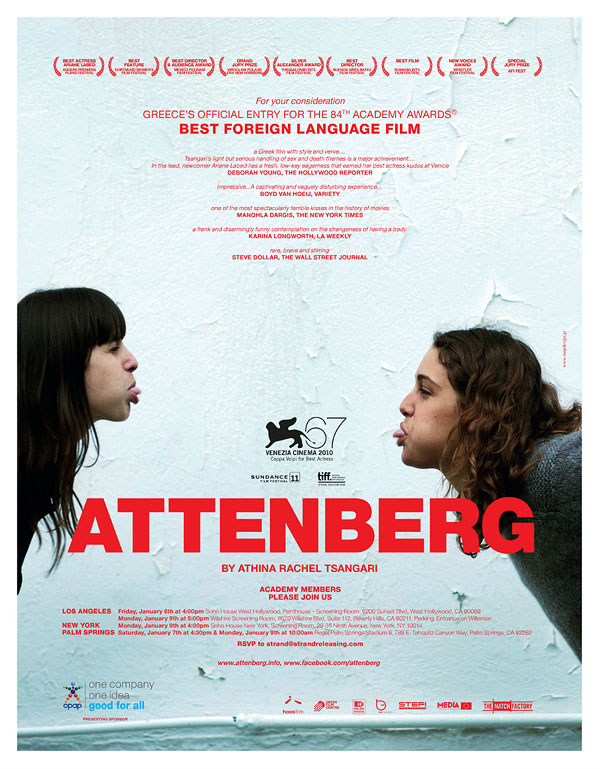
The Lobster also prompted me to further explore the genre of “Greek Weird Wave Cinema” to which Lanthimos belongs. Attenberg seems to rank pretty highly in those circles and so I was excited to check it out (and Lanthimos actually has a role as The Stranger in this film). Again, there is an overwhelming sense of dislocation and dis-ease in this film as the protagonist, Marina, moves through a world where she doesn’t feel any sense of belonging or, I think, any desire to belong. She feels more herself when mimicking the birds and wild cats she watches in documentaries or inventing marches and silly walks with her friend, than she feels mimicking other adults. But adulting is something Marina is forced to do as her father is dying and I thought the awkward and strange and tender relationship she develops with the stranger at the hotel, as she steps with some trepidation into that world, was actually quite beautiful.
I had to sit with Attenberg for awhile. I liked it more the more I thought about it (and the more I forgot it?). I think it is much better than the marketing and opening scene (where Marina’s best friend Bella attempts to teach her how to French kiss) suggest. That I had to sit with this movie to determine what I thought and felt about it is, I think, part of what attracts me to this genre of film. I’ve noticed that smart people, cultured people, highly educated people, tend to gravitate towards films and shows that are easy to think smart things about. Everyone gets all excited about Black Mirror or whatever the next smart thing is because Black Mirror is smarter than, I don’t know, 24, and then smart people can say and think smart things with Black Mirror (smartness is a lot like cultural conceptions of beauty — it’s mostly exhibited to advance one’s brand or get things that one wants and, in the grand scheme of things, I reckon it is no more or less valuable than cultural conceptions of beauty [by which I mean that it has currency even though it doesn’t really matter at all]). But Greek Weird Wave films don’t make it easy – you can watch them and be moved by them but then not know what to think about them. They dislocate you and force you to do the thinking on your own. I like this a lot. It’s a challenge that requires creativity and I find that a lot more fun than a lot of the shows for smarties (because, to be honest, shows like Black Mirror bore me and I’d rather just watch Jersey Shore or The Bachelor).
4. Miss Violence (2013) directed by Alexandros Avranas.

Because I have grown to distrust a lot of film scene films – which surprisingly often seem to revolve around some kind of presentation of horrendous sexual violence – I try to do a bit of research about the movies I choose to watch before I watch them because I don’t want to watch that kind of thing. However, I also don’t like to learn too much about the movies I watch before I watch them so as not to spoil them or have my own thoughts biased by the thoughts of others and so this can be a bit of a fine line to walk. Unfortunately, I did not walk it well with Miss Violence and discovered myself, in the final ten minutes of the movie, frozen in horror as an horrendous act of violence was played out before the unblinking gaze of the camera. It broke me down after… I can’t divorce these scenes from the experiences of so many people whom I have loved and continue to love and who have loved and continue to love me… so it was actually quite a traumatic experience. I don’t recommend this film to anyone. I’ve written a lot about my views on sexual violence in film already on this blog so I won’t say more about it here but I did nod along to a lot of what this reviewer wrote here.
5. Hunt for the Wilderpeople (2016) directed by Taiki Waititi.
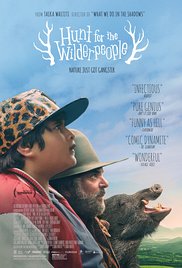
Taiki Waititi has very rapidly become my favourite comedic Director and also one of my favourite comedic actors. The first film of his I watched was What We Do In The Shadows and I loved it. One of my all-time favourite vampire movies (a genre of film which, perhaps surprisingly, contains a number of very good movies). Hunt for the Wilderpeople is his latest and it returns to some themes and places familiar to viewers from Boy (which I’ll be reviewing next month). Here, the theme is the experiences of an Indigenous youth moved from institutional care to the home of two older country folks in New Zealand. Waititi, who is himself Indigenous, does a good job of exploring relevant colonial, criminal, socioeconomic and political themes, and does so with a pretty incredible blend of honesty and humour (it’s this blend that really makes him a master of his craft as mixing these things in the wrong way can really be disastrous). Recommended viewing. Watch all his stuff.
6. Personal Shopper (2016) directed by Olivier Assayas.
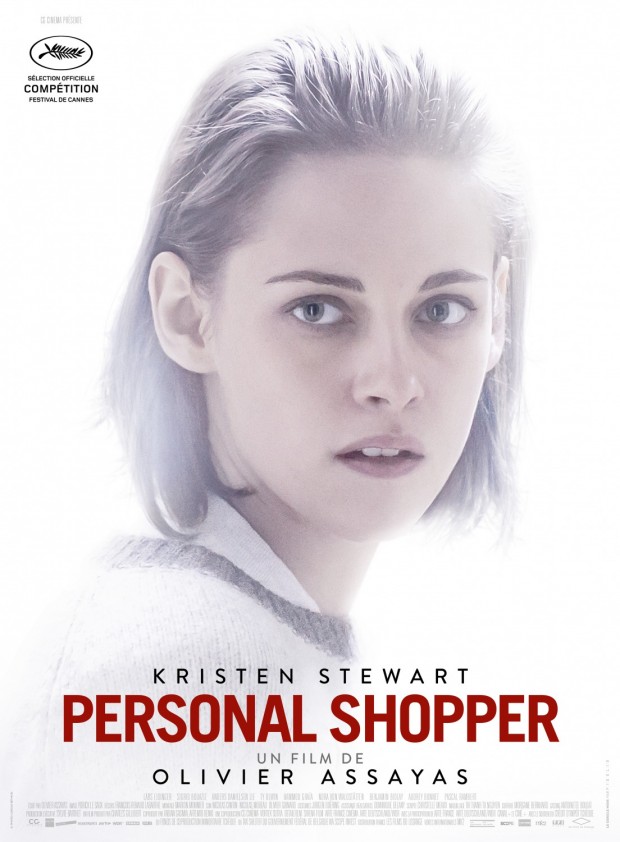
Critics seem to really love when mainstream Hollywood actors who aren’t necessarily known for their acting skills take on serious roles in European films (think Scarlett Johansson in Under the Skin or Shia LaBeouf in Nymphomaniac). I probably should have factored this in after I read about Kristen Stewart’s performance in Personal Shopper. But I didn’t and, as a result, I found this film to be a let down. Granted (SPOILERS COMING), Assayas has fun trying to weave competing interpretations into the film (ghosts, stalkers, both, neither, and, wait, is Kristen Stewart actually the one who is dead, or maybe this is all related to the stress and trauma of her twins death?) but none of them hold up particularly well on their own, nor does there seem to be an explanation that does justice to them all at once (Guillermo del Toro this ain’t). The closest I can come to an explanation is that, when people mess around with the supernatural in Assayas’ world, there’s no telling who are what they will get and we simply don’t know enough about the supernatural to make any sense of it. And, okay, I understand that maybe this is a film that doesn’t want to make complete sense, that making sense and wrapping things up turns this into more of a movie or storybook than Assayas might want it to be, and that’s fine and but, in this specific case, I didn’t feel I was left with all that much.
Documentaries
1. Incident at Restigouche (1984) directed by Alanis Obomsawin.
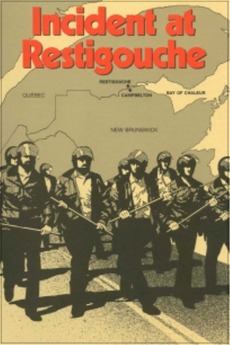
In June of 1981, the Sûreté du Québec, with the assistance of the RCMP, engaged in two massive raids on the Restigouche Reserve (the Listuguj Mi’kmaq First Nation). They did this to try and prevent the Mi’kmaq from fishing on their territorial waters (waters the Mi’kmaq had fished for many centuries before the French or English ever showed up). In these raids several Mi’kmaq people were beaten up by the cops and a considerable amount of property was destroyed. Subsequent court cases led to further abuses of the Mi’kmaq (although Appeals Courts later overruled the initial decisions). The Government of Québec argued that the raids were necessary as an environmental protection act, to protect depleting salmon stocks in the St. Lawrence River. However, while the Government was making this claim, they were also opening those waters to fishing by massive international trawlers that were taking hundreds of millions of tons of salmon out of the river (exponentially more than the Mi’kmaq were taking who, again, never had a problem with fish stocks dropping too low in all their centuries of fishing). This actually prompted blockades and far reaching Indigenous solidarity in a manner that anticipated the events at Kanehsatake in 1990 (which Obomsawin explores here).
As with all of Obomsawin’s films, I very much enjoyed this one. Her interview with Lucien Lessard, the MP from the PQ who was pulling the strings at the time, is especially fascinating. I also didn’t know anything about this incident, even after spending a lot of time over the last half dozen years exploring contemporary Canadian acts of colonial violence. There are so many to try and keep track of… Recommended viewing (it can be seen here and isn’t all that long).
2. They Call Us Monsters (2016) directed by Ben Lear.
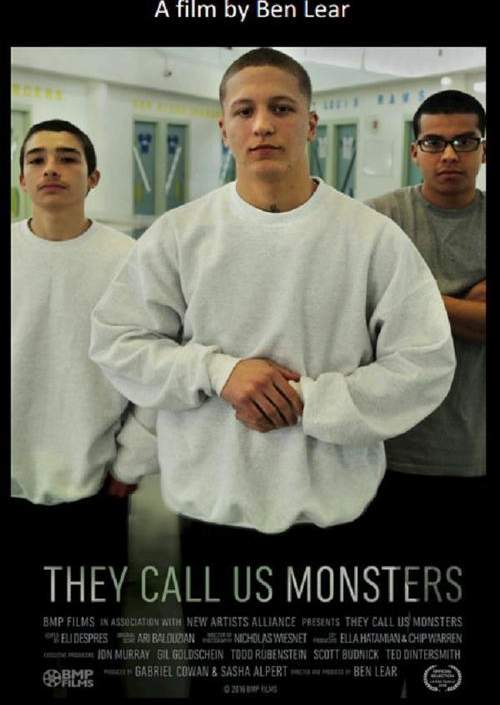
Ben Lear had a really great idea for a documentary about non-adult teens in the USofA facing life sentences in prison – teach some screenwriting workshops to them and use that as an opportunity to build relationships and film them in a way that shows their humanity, childlikeness, adultlikeness, and all around, hey, these kids are hurting and, shit, they come from some hard backgrounds and, they aren’t perfect but, hmmm, maybe locking them up for life is really tragic and cruel – but I don’t think he pulled it together all that well. I think his apparent naivety about poverty, drug use, and the so-called criminal justice system sometimes interferes with how things might be presented and even with the potential well-being of the kids he claims to want to help. His manner of presenting himself and others and his relationship with those others sometimes made me uncomfortable (plus I feel like some of the content is potentially incriminating??). Other times it feels like Lear’s not sure what to include and what to cut or how to speak well about any of it. There were parts of this film I enjoyed, but, overall, I was disappointed.